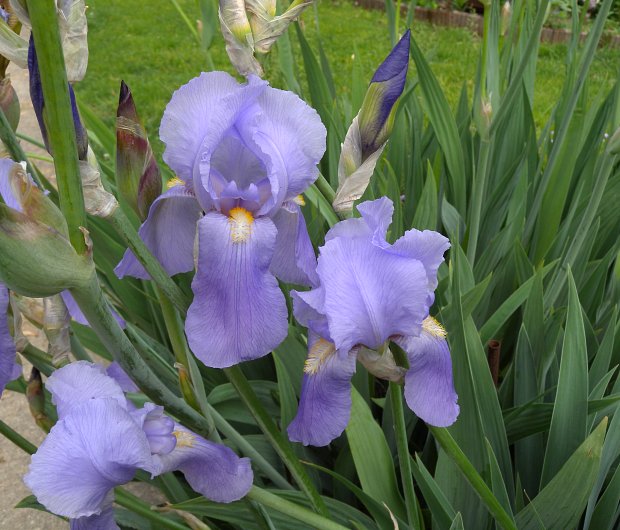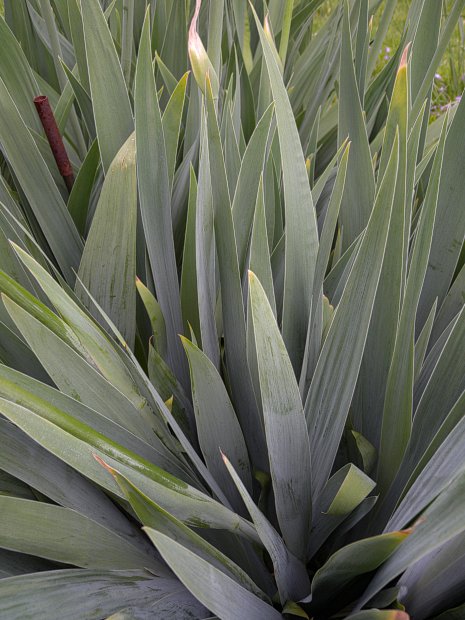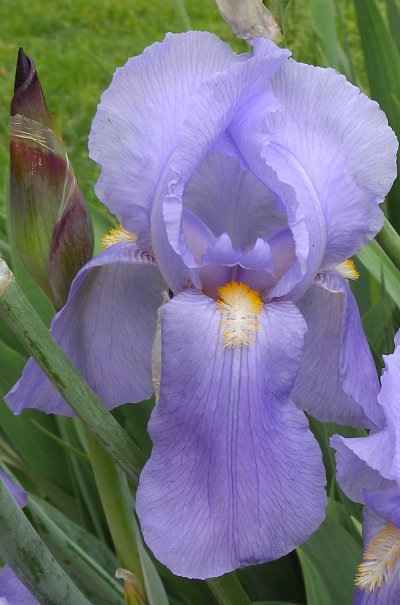German Bearded Iris
Iris × germanica
Iris family (Iridaceae)
Iris × germanica
Iris family (Iridaceae)
Description:
This perennial herbaceous plant develops one or more fans of
sword-shaped basal leaves; they are more or less erect and
semi-evergreen to evergreen. Individual basal leaves are about 1½–2'
tall, up to 1¼" across, flattened, and sword-shaped with toothless
margins. The
surface of the basal leaves is grayish green, bluish green, or green,
and usually somewhat pale; they are glabrous, often glaucous,
parallel-veined, and somewhat stiff in texture. Occasionally, erect
flowering stalks develop among the basal leaves; they are 2¼–3½' tall.
These stalks are similar in color to the basal leaves; they are terete,
slightly stout, glabrous, glaucous, and sparingly branched, producing
both axillary and terminal clusters of 2-5 flowers (or sometimes
solitary flowers). Alternate spathe-like leaves occur where each stalk
branches; they are much reduced in size and lanceolate in shape,
wrapping around the adjacent stalk at the base. Otherwise, the
characteristics of the alternate leaves are similar to the basal leaves
and stalks. Individual
flowers span about 2–3½" across and 3–4½" tall (usually taller than
across), consisting of 3 petals, 3 sepals, 3 petaloid flattened styles,
3 hidden stamens, and a three-celled inferior ovary.

Because of numerous cultivars, the petals, sepals, and petaloid styles can be highly variable in color, although they are typically some shade of blue-violet, pale blue-violet, white, purple, pink, or some combination of the preceding colors. The petals are upright, curving slightly inward, and oblanceolate in shape; they are often slightly wavy to moderately crinkled along their margins. The sepals spread outward and droop downward; they are also oblanceolate in shape, and they have a visible band of white or yellow hairs toward the base. A little above the sepals, but substancially shorter, is where the petaloid styles are located; they are oblong in shape with tips that are bifurcated and somewhat ragged or crinkled. The ovary is grayish green, bluish green, or green, oblongoid, and mostly 3-lobed in shape. At the base of each flower, there is the withered remnant of the floral spathe that formerly enclosed the floral bud. The young spathe is similar in color to the foliage, but it is narrowly membranous along its outer margins and sometimes tinted blue-violet or purple. The blooming period occurs from late spring to early summer, lasting about 2 weeks for a colony of plants. Individual flowers last only a few days. The ovaries mature into 3-celled seed capsules about 1¼–2" long. After they become dark brown later in the year, the seed capsules divide into 3 parts to release the seeds (there are 2 rows of seeds for each cell of the seed capsule). These seeds are about 3-4 mm. long, dark brown, wrinkled, and somewhat flattened in appearance. They can be distributed by wind or water. The root system has thick brown rhizomes with coarse fibrous roots along their undersides. This plant often forms clonal colonies from the spreading rhizomes.

Cultivation: The preference is full sun, moist to mesic conditions, and soil containing loam, clay loam, or other material. Most cultivars of this plant are easy to cultivate in the garden and they tend to be long-lived. Propagation is by seeds (they shouldn't be allowed to dry out) or division of rhizomes (this latter method is easier). Seedlings of cultivars do not necessarily have the same floral colors as their parents.
Range & Habitat: The German Bearded Iris (Iris × germanica) has naturalized in widely scattered areas of Illinois (see Distribution Map). Naturalized plants can persist for either short or long periods of times. This iris is native to central and southern Europe and it is thought to be a hybrid of Iris pallida and Iris variegata. However, later cultivars may also contain the genes of other Iris spp. in Europe and Asia. The German Bearded Iris was introduced into North America from Europe and it is widely cultivated in gardens, from where this plant occasionally escapes. The German Bearded Iris is not regarded as invasive in Illinois. Habitats of naturalized plants consist primarily of roadsides, areas along railroads, sites of abandoned homesteads, areas near flower gardens, and waste areas. This naturalized iris is normally found in highly disturbed areas, although it has also been found in high quality prairies that are sites of old pioneer cemeteries.
Faunal Associations: The flowers attract primarily long-tongued bees, especially bumblebees (Bombus spp.). Both nectar and pollen are available as floral rewards. The Ruby-throated Hummingbird may also visit the flowers for nectar. Other floral visitors, such as short-tongued bees, ants, butterflies, and beetles, may also visit the flowers, but they are regarded as non-pollinating. Other insects feed destructively on the rhizomes, leaves, plant juices, seeds, and stem interiors of this and other irises (Iris spp.). They include such species as the larvae of leaf-miner flies (Cerodontha spp.), larvae of bulb flies (Eumerus spp.), the Tulip Bulb Aphid (Dysaphis tulipae) and other aphids, the Ground Mealybug (Rhizoecus falcifer), stink bugs (Euschistus spp.), larvae of stem borer moths (Papaipema spp.), and Western Flower Thrips (Frankliniella occidentalis); see the Insect Table for a more complete list of these species. Among vertebrate animals, irises have little value as food because the foliage and rhizomes are toxic and rather coarse.

Photographic Location: A flower garden at Meadowbrook Park in Urbana, Illinois.
Comments: There are now thousands of cultivars of the German Bearded Iris (Iris × germanica) and its attractive flowers occur in a wide variety of colors. It can be readily distinguished from native irises by the presence of tufted hairs on the petaloid sepals of its flowers. The flowers of native irises in Illinois often have colorful bands of color on their sepals, but they lack tufted hairs. The flowers of native irises are primarily blue-violet or copper-colored (the latter applies only to Iris fulva) and their flowers are as wide or wider than they are tall. In contrast, the flowers of the German Bearded Iris are as tall or taller than they are wide. The tufts of hair on the petaloid sepals of the German Bearded Iris and other old-world irises (Iris spp.) lure insects to the flowers because of their superficial resemblance to pollen-bearing stamens. In this regard, they use a little bit of deception to lure potential flower pollinators.

Because of numerous cultivars, the petals, sepals, and petaloid styles can be highly variable in color, although they are typically some shade of blue-violet, pale blue-violet, white, purple, pink, or some combination of the preceding colors. The petals are upright, curving slightly inward, and oblanceolate in shape; they are often slightly wavy to moderately crinkled along their margins. The sepals spread outward and droop downward; they are also oblanceolate in shape, and they have a visible band of white or yellow hairs toward the base. A little above the sepals, but substancially shorter, is where the petaloid styles are located; they are oblong in shape with tips that are bifurcated and somewhat ragged or crinkled. The ovary is grayish green, bluish green, or green, oblongoid, and mostly 3-lobed in shape. At the base of each flower, there is the withered remnant of the floral spathe that formerly enclosed the floral bud. The young spathe is similar in color to the foliage, but it is narrowly membranous along its outer margins and sometimes tinted blue-violet or purple. The blooming period occurs from late spring to early summer, lasting about 2 weeks for a colony of plants. Individual flowers last only a few days. The ovaries mature into 3-celled seed capsules about 1¼–2" long. After they become dark brown later in the year, the seed capsules divide into 3 parts to release the seeds (there are 2 rows of seeds for each cell of the seed capsule). These seeds are about 3-4 mm. long, dark brown, wrinkled, and somewhat flattened in appearance. They can be distributed by wind or water. The root system has thick brown rhizomes with coarse fibrous roots along their undersides. This plant often forms clonal colonies from the spreading rhizomes.

Cultivation: The preference is full sun, moist to mesic conditions, and soil containing loam, clay loam, or other material. Most cultivars of this plant are easy to cultivate in the garden and they tend to be long-lived. Propagation is by seeds (they shouldn't be allowed to dry out) or division of rhizomes (this latter method is easier). Seedlings of cultivars do not necessarily have the same floral colors as their parents.
Range & Habitat: The German Bearded Iris (Iris × germanica) has naturalized in widely scattered areas of Illinois (see Distribution Map). Naturalized plants can persist for either short or long periods of times. This iris is native to central and southern Europe and it is thought to be a hybrid of Iris pallida and Iris variegata. However, later cultivars may also contain the genes of other Iris spp. in Europe and Asia. The German Bearded Iris was introduced into North America from Europe and it is widely cultivated in gardens, from where this plant occasionally escapes. The German Bearded Iris is not regarded as invasive in Illinois. Habitats of naturalized plants consist primarily of roadsides, areas along railroads, sites of abandoned homesteads, areas near flower gardens, and waste areas. This naturalized iris is normally found in highly disturbed areas, although it has also been found in high quality prairies that are sites of old pioneer cemeteries.
Faunal Associations: The flowers attract primarily long-tongued bees, especially bumblebees (Bombus spp.). Both nectar and pollen are available as floral rewards. The Ruby-throated Hummingbird may also visit the flowers for nectar. Other floral visitors, such as short-tongued bees, ants, butterflies, and beetles, may also visit the flowers, but they are regarded as non-pollinating. Other insects feed destructively on the rhizomes, leaves, plant juices, seeds, and stem interiors of this and other irises (Iris spp.). They include such species as the larvae of leaf-miner flies (Cerodontha spp.), larvae of bulb flies (Eumerus spp.), the Tulip Bulb Aphid (Dysaphis tulipae) and other aphids, the Ground Mealybug (Rhizoecus falcifer), stink bugs (Euschistus spp.), larvae of stem borer moths (Papaipema spp.), and Western Flower Thrips (Frankliniella occidentalis); see the Insect Table for a more complete list of these species. Among vertebrate animals, irises have little value as food because the foliage and rhizomes are toxic and rather coarse.

Photographic Location: A flower garden at Meadowbrook Park in Urbana, Illinois.
Comments: There are now thousands of cultivars of the German Bearded Iris (Iris × germanica) and its attractive flowers occur in a wide variety of colors. It can be readily distinguished from native irises by the presence of tufted hairs on the petaloid sepals of its flowers. The flowers of native irises in Illinois often have colorful bands of color on their sepals, but they lack tufted hairs. The flowers of native irises are primarily blue-violet or copper-colored (the latter applies only to Iris fulva) and their flowers are as wide or wider than they are tall. In contrast, the flowers of the German Bearded Iris are as tall or taller than they are wide. The tufts of hair on the petaloid sepals of the German Bearded Iris and other old-world irises (Iris spp.) lure insects to the flowers because of their superficial resemblance to pollen-bearing stamens. In this regard, they use a little bit of deception to lure potential flower pollinators.